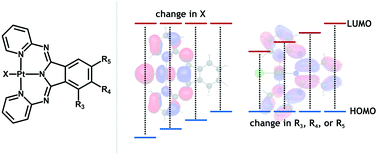A series of twelve platinum(II) complexes of the form (N^N^N)PtX have been synthesized and characterized where N^N^N is 1,3-bis(2-pyridylimino)isoindolate ligands (BPI) or BPI ligands whose aryl moieties are substituted with tert-butyl, nitro, alkoxy, iodo or chloro groups, and X is a chloride, fluoride, cyano, acetate, phenyl or 4-(dimethylamino)phenyl ligand. All complexes display at least one irreversible oxidation and two reversible reduction waves at potentials dependent on the position and the electron donating or withdrawing nature of both X and the substituted N^N^N ligand. Broad room temperature phosphorescence ranging in energy from 594 to 680 nm was observed from the complexes, with quantum efficiencies ranging from 0.01 to 0.05. The efficiency of emission is dictated largely by nonradiative processes since the rate constants for nonradiative deactivation [(1.1–100) × 105 s−1] show greater variation than those for radiative decay [(0.57–4.0) × 04 s−1]. Nonradiative deactivation for compounds with X = Cl follow the energy gap law, i.e. the nonradiative rate constants increase exponentially with decreasing emission energy. Deactivation of the excited state appears to be strongly influenced by a non-planar distortion of the BPI ligand.

You have access to this article
 Please wait while we load your content...
Something went wrong. Try again?
Please wait while we load your content...
Something went wrong. Try again?


 Please wait while we load your content...
Please wait while we load your content...